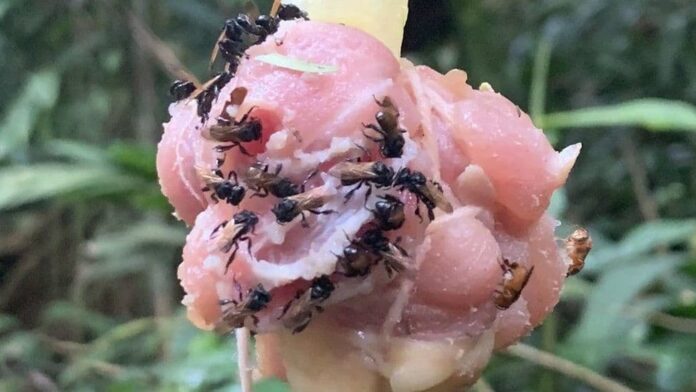Looks like we are getting on the dark side of the animals lately, and here is another one for you. The vulture bee is a carnivorous bee species that does not care any less for nectar or pollen. This bee’s diet is on a whole new level, and we are going to learn a thing or two about them today. If you have never heard of a vulture bee before, you are at the right place.
1Appearance
A vulture bee has a reddish-brown body, growing to a length of 0.8 to 2.2 centimeters. Its body is small and robust with slender and parallel sides. Since it does not collect pollen, it is not hairy at all though it has a few short pale hairs on its thorax. Instead of having a stinger, this stingless bee has strong and powerful mandibles that it uses to tear off flesh. They also evolve to have 5 large pointy teeth that allow them to slice chunks of meat off the carcasses.
2Behavior
As social bees, they live in colonies that consist of the typical bee hierarchy: queen, worker, drone, and larva. A vulture bee colony is built in cavities such as tree hollows or underground holes, or high up in trees. Sometimes they also take over abandoned termite nests as well. Their nest is typically made from a mixture of bee feces, decomposing vegetal particles, mud, resins, soils, and wax.
Living up to their reputation, vulture bees are fast when it comes to carcass detection and skeletonizing their meal. Some observations showed that they also attack and rob competitors for food and nest sites. This is why small foraging creatures like ants tend to steer clear of vulture bees. The vulture bees are also aggressive, and everything about this little insect is quite intimidating. Those large pointy teeth also support their painful biting, so it is advisable to maintain your distance from them. Since they react in swarms even at the smallest disturbance, they will violently attack the intruder by biting.
3Feeding & Habitats
Carrion bee is another nickname for this insect, and it is the only stingless bee species that feeds on rotting meat. For vulture bees, there are 3 distinct groups that all get their protein from carcasses including Trigona crassipes, Trigona hypogea, and Trigona necrophages. Among the dozens of animal species that they forage, the most common carcasses are birds, fish, lizards, monkeys, and snakes. The forager bees in the colony enter dead animals through the eye sockets to collect flesh for later consumption. Do vulture bees produce honey when they don’t feed on nectar and pollen at all like this? They do, vulture bees produce a substance similar to royal jelly from protein-rich secretions of their hypopharyngeal glands.
When they come back from foraging, the forager bees regurgitate and pass the flesh to a worker bee for storage. They consume the flesh and process it by their highly acidic gut which can break down the meat. And then they regurgitate a honey-like substance from the hypopharyngeal glands and store it in special chambers in their hives. It takes around two weeks to mature before it becomes a paste-like substance that is rich in amino acids and sugars. Just to clarify, flesh and honey are two different things, and “meat honey” does not exist. Though feeding on flesh, the researchers said that vulture bees’ honey is still sweet and edible. Is there any proof of anyone tasting their honey? I haven’t found one yet.
Vulture bee colonies live in warmer and neotropical climates such as jungles and rainforests throughout South America including Argentina, Brazil, and Mexico. There is not a lot of information about vulture bees yet, but hopefully, there will be more studies about them.
Related Post: Neon Cuckoo Bee Facts




